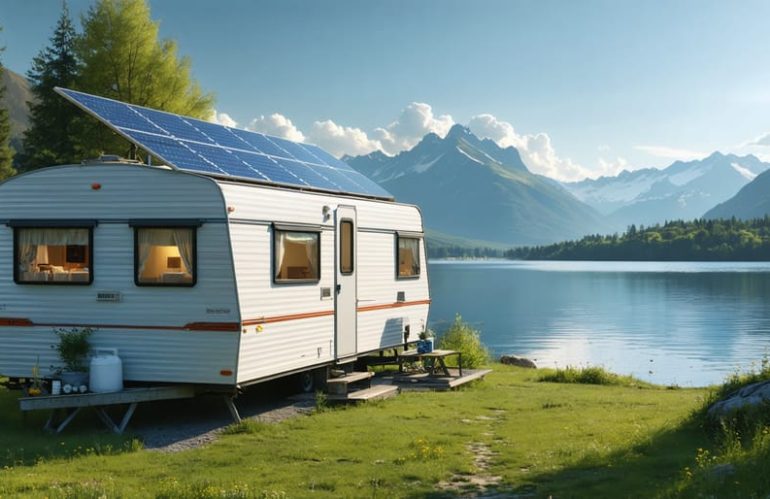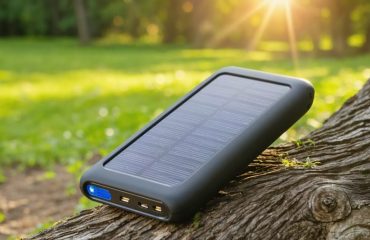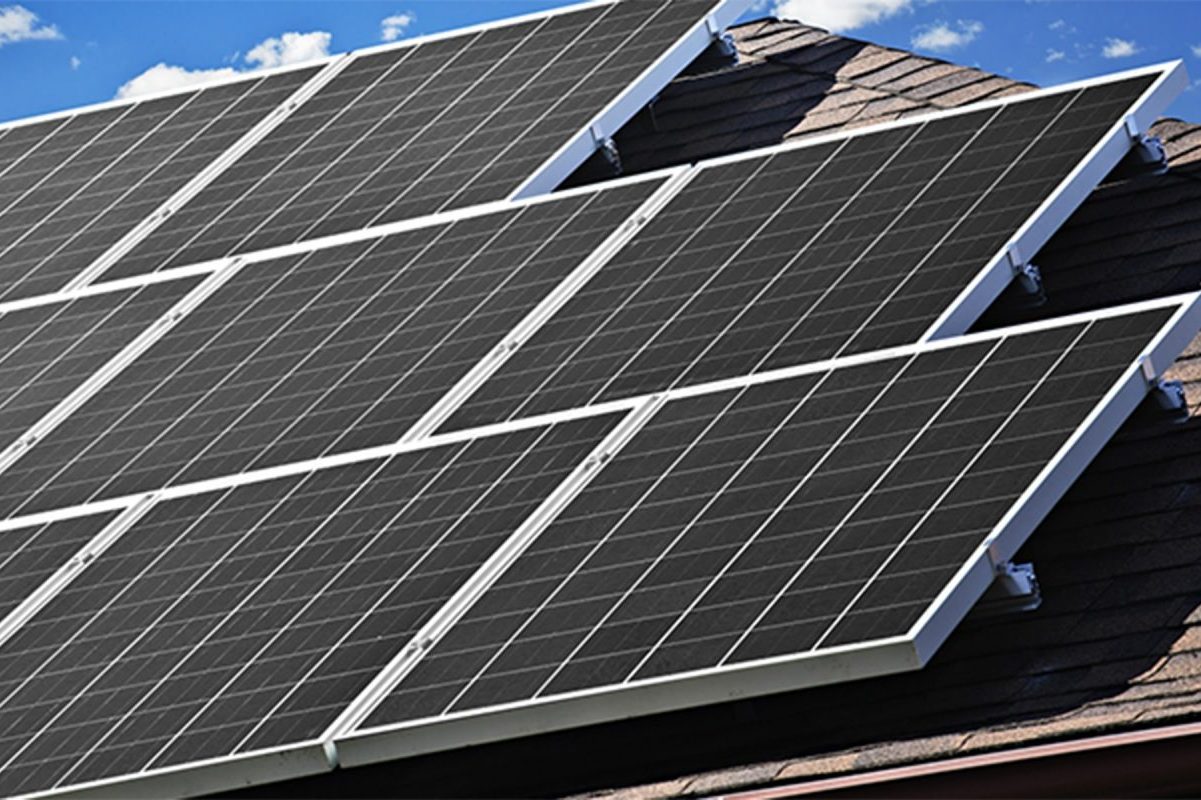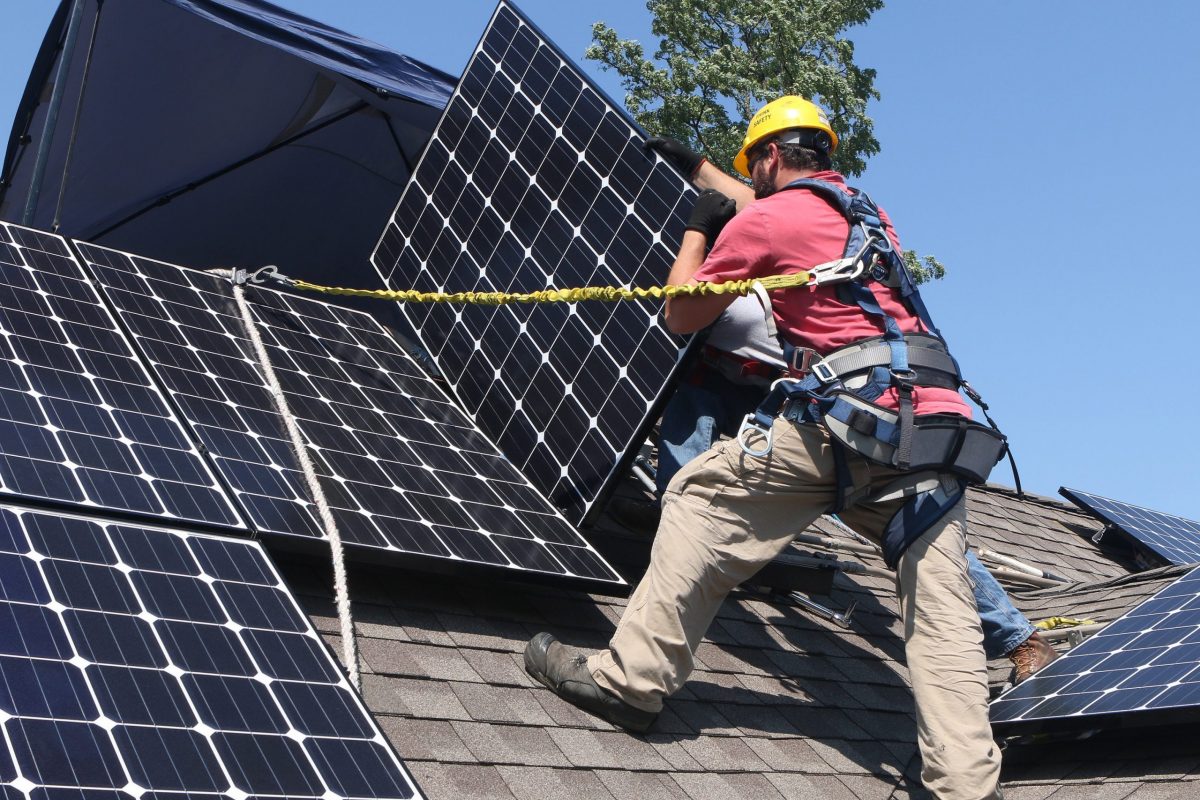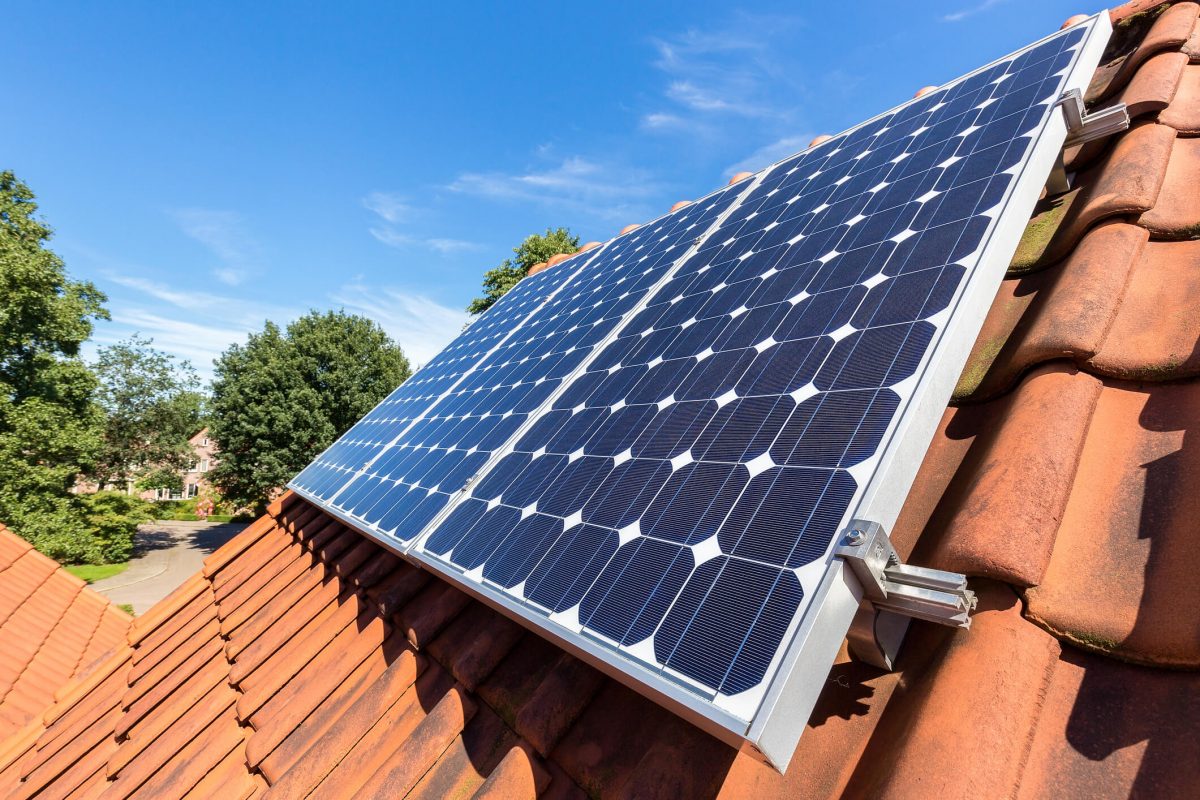Transform your mobile lifestyle with cutting-edge mobile solar solutions that combine freedom and sustainability. Solar-powered mobile homes represent the perfect intersection of eco-conscious living and modern convenience, offering energy independence whether you’re parked in a remote wilderness or a suburban RV park. By harnessing the sun’s power through roof-mounted photovoltaic panels, these homes generate clean electricity for everything from basic appliances to advanced smart home systems, potentially eliminating monthly utility bills entirely. Recent advances in solar technology, including more efficient panels and improved battery storage systems, have made it easier than ever to power a mobile home entirely off-grid. This sustainable approach to mobile living not only reduces environmental impact but also provides significant long-term cost savings, making it an increasingly popular choice for both weekend adventurers and full-time nomads seeking a greener, more independent lifestyle.
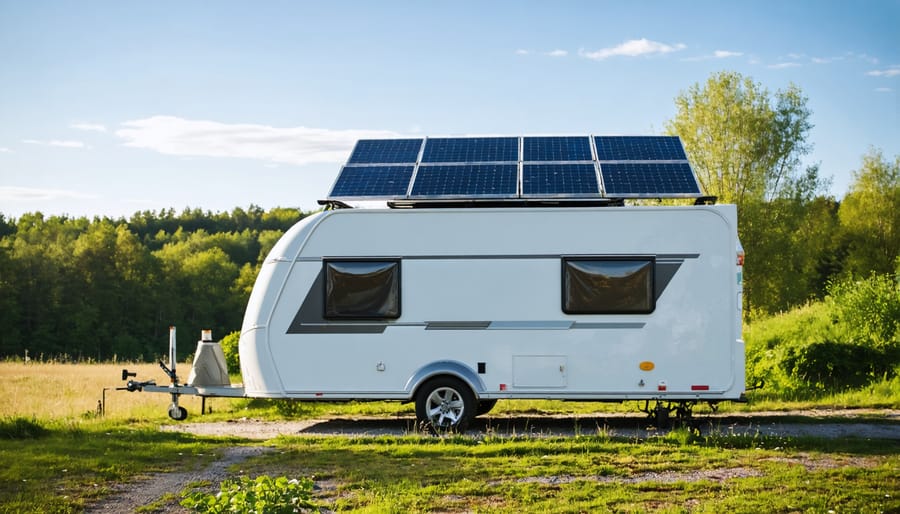
How Solar Power Transforms Mobile Home Living
Essential Components of a Solar Mobile Home System
A solar-powered mobile home system relies on four key components working together seamlessly to provide reliable, renewable energy. The heart of the system is the solar panel array, typically mounted on the roof or deployed as portable units. These panels capture sunlight and convert it into electricity, with most mobile homes requiring between 4-8 panels depending on energy needs and available space.
Energy storage is crucial for continuous power supply, which is why deep-cycle batteries are essential. These specially designed batteries store excess energy generated during sunny periods for use during nighttime or cloudy days. Lithium-ion batteries are becoming increasingly popular due to their longer lifespan and better performance compared to traditional lead-acid alternatives.
The inverter serves as the system’s brain, converting the DC power stored in batteries into AC power that your home appliances can use. Modern inverters often include smart features that help optimize energy consumption and provide real-time performance data. For mobile homes, pure sine wave inverters are recommended as they provide cleaner power that’s safer for sensitive electronics.
A monitoring system helps you track energy production, consumption, and battery levels. These systems usually include user-friendly apps that display real-time data and alert you to any potential issues. Many modern monitoring solutions also offer remote access, allowing you to check your system’s performance from anywhere.
Additional components include charge controllers to prevent battery overcharging, proper wiring and connectors rated for outdoor use, and mounting hardware designed specifically for mobile home applications. Together, these components create a reliable, efficient system that can power your mobile lifestyle while reducing your carbon footprint.

Energy Independence on the Move
Solar-powered mobile homes represent the pinnacle of energy independence, offering freedom from traditional utility connections while embracing sustainable tiny living. With a well-designed solar system, you can power your entire mobile home while traveling across the country or settling in remote locations.
Modern solar technology makes it possible to generate and store enough electricity for all your daily needs, from running appliances and electronics to maintaining comfortable temperatures. The key advantage is the ability to harness energy wherever you go – whether you’re parked at a scenic mountain overlook or camping in the desert.
Your solar-powered mobile home becomes a self-contained energy hub, collecting power during daylight hours and storing it in batteries for nighttime use. This independence means you’re no longer tethered to RV parks or campgrounds for power hookups, opening up countless possibilities for where you can stay and how long you can remain off-grid.
The system’s flexibility allows you to adjust your energy consumption based on available sunlight and weather conditions. Many mobile homeowners find they become more conscious of their energy usage, naturally adopting sustainable habits while maintaining modern comforts. This combination of mobility and renewable energy creates an unparalleled sense of freedom and environmental responsibility.
Smart Integration for Maximum Efficiency
Mobile Apps and Energy Monitoring
Modern solar-powered mobile homes benefit greatly from smart technology integration, making energy monitoring and management easier than ever. With user-friendly mobile apps, you can track your solar system’s performance right from your smartphone, giving you real-time insights into power generation and consumption.
These apps typically display essential information like current energy production, battery status, and historical usage patterns. You can monitor how much energy your panels are generating throughout the day and adjust your consumption habits accordingly. Many apps also send notifications about system performance and maintenance needs, helping you maintain optimal efficiency.
Smart monitoring solutions often include features like remote system control, allowing you to manage your power usage even when you’re away from home. You can turn appliances on or off, schedule energy-intensive tasks during peak solar production hours, and receive alerts about potential issues before they become problems.
Some advanced apps even provide weather forecasts and solar production predictions, helping you plan your energy usage around expected solar generation. This integration of mobile technology with solar power systems makes sustainable living more accessible and manageable for mobile homeowners, while potentially increasing energy savings through informed usage decisions.
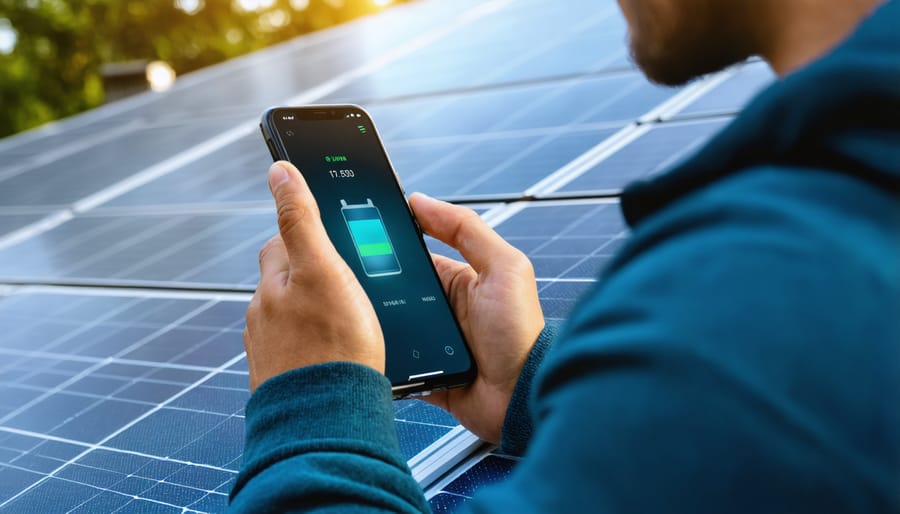
Automated Energy Management
Modern solar-powered mobile homes come equipped with sophisticated energy management systems that take the guesswork out of power consumption. These smart systems automatically monitor and optimize your energy usage, ensuring you get the most from your solar investment.
At the heart of this automation is the solar charge controller, which intelligently manages power flow between your panels, batteries, and appliances. It automatically adjusts charging rates based on battery levels and available sunlight, protecting your batteries while maximizing energy capture.
Smart inverters work alongside these controllers, seamlessly switching between solar, battery, and grid power when needed. Many systems now include smartphone apps that let you monitor your energy production and usage in real-time. You can track how much power you’re generating, storing, and consuming, all from your phone.
These systems can also learn your usage patterns and automatically adjust power distribution. For example, they might prioritize running energy-intensive appliances during peak sunlight hours or store extra power when sunny weather is forecasted. Some advanced setups even integrate with smart home devices, allowing automated scheduling of appliances to optimize energy efficiency.
With automated management, you can enjoy sustainable living without constantly monitoring your power system.
Practical Considerations and Installation
System Sizing and Requirements
Determining the right solar system size for your mobile home involves carefully assessing your energy needs and available space. Start by calculating your average daily energy consumption in kilowatt-hours (kWh). Review your past 12 months of electricity bills to get an accurate picture of your usage patterns throughout the year.
For a typical mobile home, energy consumption usually ranges from 200 to 400 kWh per month. Consider all your electrical appliances, including heating, cooling, and solar-powered utilities. A good rule of thumb is to plan for about 100 square feet of solar panels for every 1,000 kWh of monthly electricity use.
Factor in your location’s sun exposure and climate conditions. Southern states typically need fewer panels due to higher solar irradiance, while northern regions might require additional panels to compensate for fewer sun hours. Also, consider your roof’s orientation and available mounting space – most mobile homes can accommodate 4-8 solar panels comfortably.
For optimal performance, we recommend a system size between 2kW and 4kW for most mobile homes. This usually consists of 6-12 solar panels, depending on their efficiency rating. Remember to include some buffer capacity for future needs and seasonal variations in energy consumption.
Installation and Maintenance Tips
Proper installation of your mobile home solar system starts with a thorough site assessment to determine optimal panel placement. Position panels where they’ll receive maximum sunlight exposure, typically on the roof or nearby ground mounts. Always ensure your roof can support the additional weight, and consider reinforcement if necessary.
For best results, panels should face south (in the Northern Hemisphere) at a 30-45 degree angle. Install mounting brackets securely, using appropriate weatherproofing to prevent any leaks. Connect wiring through proper conduits to protect against weather and wildlife damage.
Regular maintenance is crucial for system longevity. Inspect panels quarterly for dirt, debris, or damage. Clean panels with plain water and a soft brush – avoid harsh chemicals that might damage the surface. Check wiring connections annually for signs of wear or loosening.
Monitor your battery bank’s performance monthly, ensuring proper charge levels and checking for corrosion on terminals. Keep battery areas well-ventilated and clean. During winter months, clear snow from panels promptly to maintain efficiency.
Keep detailed maintenance records and schedule professional inspections annually. This helps identify potential issues before they become serious problems. Most solar systems have a 25-year lifespan, but proper installation and regular maintenance can extend their efficiency and durability significantly.
Remember to periodically update your monitoring system software and check that all components are functioning optimally. Quick response to any performance changes can prevent costly repairs down the line.
Embracing solar power for your mobile home represents a forward-thinking approach to sustainable living that offers numerous advantages. By harnessing the sun’s energy, you’ll significantly reduce your carbon footprint while enjoying substantial savings on energy bills. The initial investment in solar panels and equipment pays off through years of reduced utility costs and potential tax incentives, making it a financially sound decision for the long term.
The flexibility of solar power systems means you can start small and expand as needed, adapting to your energy requirements and budget. Whether you’re planning weekend getaways or full-time mobile living, solar power provides the independence and reliability you need, free from the constraints of traditional power hookups.
As technology continues to advance and solar equipment becomes more affordable, there’s never been a better time to consider this eco-friendly power solution. By making the switch to solar, you’re not just investing in your mobile home; you’re investing in a cleaner, more sustainable future while enjoying the freedom of mobile living powered by the sun.
Take the first step toward energy independence today – your wallet and the planet will thank you.

